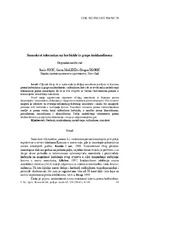Приказ основних података о документу
Sunflower resistance to herbicides of imidazolinones group
Suncokret tolerantan na herbicide iz grupe imidazolinona
| dc.creator | Jocić, Siniša | |
| dc.creator | Malidža, Goran | |
| dc.creator | Škorić, Dragan | |
| dc.date.accessioned | 2021-04-26T18:01:59Z | |
| dc.date.available | 2021-04-26T18:01:59Z | |
| dc.date.issued | 2004 | |
| dc.identifier.issn | 0354-5695 | |
| dc.identifier.uri | http://fiver.ifvcns.rs/handle/123456789/248 | |
| dc.description.abstract | The objective of this investigation was to determine the response of wild sunflower to a number of acetolactate synthase (ALS) inhibitors. An imazethapyr- resistant wild sunflower (Helianthus annuus L) population from Kansas, used in the expermiment, was tested with other selected imidazolinone (imazamox, imazapyr) and sulfonylurea herbicides (primisulfuron, rimsulfuron, thifensulfuron, prosulfuron, oxasulfuron iodosulfuron, chlorsulfuron and triflusulfuron). Another aim of this research was to determine both, the genes responsible for this resistance and the mode of inheritance. In order to achieve this goal, an imazethapyr-resistant wild sunflower population was crossed to the susceptible inbred line Ha-26. The F2 generation of this interspecific cross, as well as, the BC1 and BC2 were derived in the greenhouse. The obtained results show that the previously detected resistance includes not only imazethapyr but also imazamox and imazapyr. Imidazolinone-resistant wild sunflower is susceptible to the common rates of chlorsulfuron iodosulfuron, oxasulfuron, prosulfuron and rimsulfuron. This means that it will be possible to use these herbicides in the future to control imazethapyr-resistant sunflowers in areas where no resistance to sulfonylurea herbicides has been registered. The F1 progeny of wild sunflower crossed to the cultivated sunflower exhibited partial resistance to imazethapyr, imazamox and imazapyr under field conditions. The obtained results show that the resistance is semi-dominant in F1 generation. The segregation ratio in the F2 generation is 1:2:1 for semi-dominance. The incorporation of this trait into the cultivated sunflower will significantly improve the weed control in sunflower, since the currently used methods do not provide efficient weed control in this crop species. | en |
| dc.description.abstract | Cilj rada bio je da se ispita reakcija divljeg suncokreta poreklom iz Kanzasa prema herbicidima iz grupa imidazolinona i sulfonilurea, kao i da se utvrdi način nasleđivanja tolerantnosti prema imazetapiru, da bi se ovo svojstvo sa većom verovatnoćom prenelo u komercijalne inbred linije suncokreta. Pored ranije registrovane otpornosti divljeg suncokreta iz Kanzasa prema imazetapiru i imazamoksu, dokazana je i njegova rezistentnost prema imazapiru. Ovo svojstvo moguće je iskoristiti za stvaranje rezistentnog kulturnog suncokreta i samim tim omogućiti primenu ovih herbicida u suzbijanju korova. Suncokret tolerantan prema imidazolinonima osetljiv je prema većem broju sulfonilurea herbicida, a naročito prema hlorsulfuronu, prosulfuronu, rimsulfuronu i oksasulfuronu. Način nasleđivanja tolerantnosti prema imidazolinonima je parcijalna dominacija i za nju je odgovoran jedan gen. | sr |
| dc.publisher | Savez poljoprivrednih inženjera i tehničara, Beograd | |
| dc.rights | openAccess | |
| dc.source | Journal of Scientific Agricultural Research | |
| dc.subject | herbicid | sr |
| dc.subject | imidazolinoni | sr |
| dc.subject | nasleđivanje | sr |
| dc.subject | sulfonilurea | sr |
| dc.subject | suncokret | sr |
| dc.title | Sunflower resistance to herbicides of imidazolinones group | en |
| dc.title | Suncokret tolerantan na herbicide iz grupe imidazolinona | sr |
| dc.type | article | |
| dc.rights.license | ARR | |
| dc.citation.epage | 89 | |
| dc.citation.issue | 1 | |
| dc.citation.other | 65(1): 81-89 | |
| dc.citation.spage | 81 | |
| dc.citation.volume | 65 | |
| dc.identifier.fulltext | http://fiver.ifvcns.rs/bitstream/id/1104/245.pdf | |
| dc.identifier.rcub | https://hdl.handle.net/21.15107/rcub_fiver_248 | |
| dc.type.version | publishedVersion |


